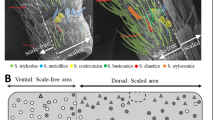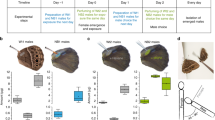Abstract
IT is very difficult to define the mechanism by which olfactory receptors on male moth antennae perceive a sex attractant chemical because of the various unsubstantiated olfaction theories, and also because of conflicting reports of the ability of chemicals, structurally different from natural sex attractants, to either inhibit1–5 or mimic6–9 attractant activity. Using the synthetic red-banded leaf roller moth (Argyrotaenia velutinana) sex attractant (RiBLuRe)10, we have been able to obtain evidence that the geometrical isomer inhibits the response of males to the sex attractant chemical, and that varying degrees of inhibition can be elicited with positional isomers, homologues and analogues. The preliminary data support a mechanism of perception in which the sex attractant, a chemical with the correct spatial arrangement of active sites, possesses the affinity and intrinsic activity for the receptor sites to elicit proper behavioural responses, including flight to the location of the sex attractant. Closely related isomers which do not display intrinsic activity by attracting males apparently can possess a strong affinity for the receptor sites, thus acting as inhibitors or modifiers of the sensory input.
This is a preview of subscription content, access via your institution
Access options
Subscribe to this journal
Receive 51 print issues and online access
$199.00 per year
only $3.90 per issue
Buy this article
- Purchase on Springer Link
- Instant access to full article PDF
Prices may be subject to local taxes which are calculated during checkout
Similar content being viewed by others
References
Eiter, K., Truscheit, E., and Boners, M., Liebigs Ann. Chem., 709, 29 (1967).
Water, R. M., and Jacobson, M., J. Econ. Entomol., 58, 370 (1965).
Jacobson, M., and Smalls, L. A., J. Econ. Entomol., 59, 414 (1966).
Shorey, H. H., and Gaston, L. K., Ann. Entomol. Soc. Amer., 60, 847 (1967).
Jacobson, M., and Smalls, L. A., J. Econ. Entomol., 60, 296 (1967).
Berger, R. S., and Canerday, T. D., J. Econ. Entomol., 61, 452 (1968).
Green, N., Jacobson, M., Henneberry, T. J., and Kishaba, A. N., J. Med. Chem., 10, 533 (1967).
Jacobson, M., Toba, H. H., DeBolt, J., and Kishaba, A. N., J. Econ. Entomol., 61, 84 (1968).
Warthen, D., and Jacobson, M., J. Med. Chem., 11, 373 (1968).
Roelofs, W. L., and Arn, H., Nature, 219, 513 (1968).
Jacobson, M., Insect Sex Attractants, 100 (Interscience, New York, 1965).
Author information
Authors and Affiliations
Rights and permissions
About this article
Cite this article
ROELOFS, W., COMEAU, A. Sex Pheromone Perception. Nature 220, 600–601 (1968). https://doi.org/10.1038/220600a0
Received:
Issue Date:
DOI: https://doi.org/10.1038/220600a0
This article is cited by
-
Parapheromones for Thynnine Wasps
Journal of Chemical Ecology (2016)
-
10.1007/BF00335886
CrossRef Listing of Deleted DOIs (2011)
-
10.1007/BF00295228
CrossRef Listing of Deleted DOIs (2011)
-
Male moth sensitivity to multicomponent pheromones: Critical role of female-released blend in determining the functional role of components and active space of the pheromone
Journal of Chemical Ecology (1986)
-
Chemical communication in invertebrates
Experientia (1986)
Comments
By submitting a comment you agree to abide by our Terms and Community Guidelines. If you find something abusive or that does not comply with our terms or guidelines please flag it as inappropriate.



